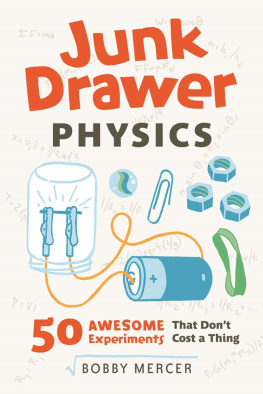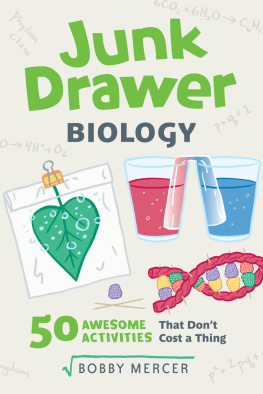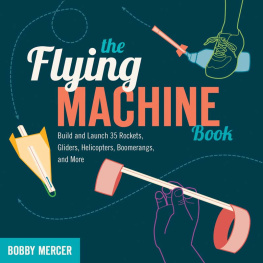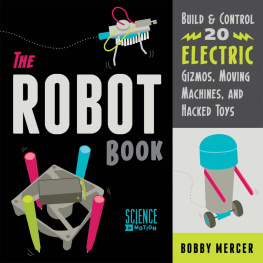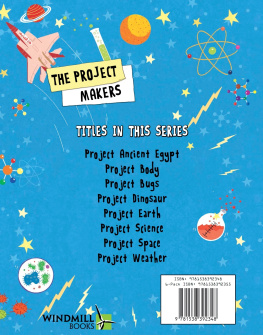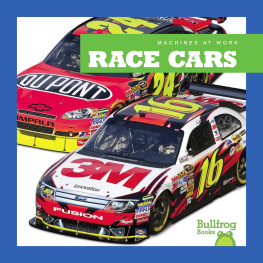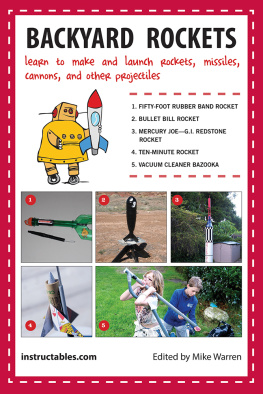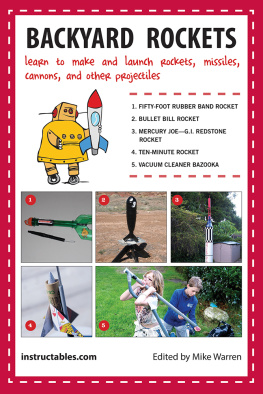

Copyright 2013 by Bobby Mercer
All rights reserved
First edition
Published by Chicago Review Press, Incorporated
814 North Franklin Street
Chicago, Illinois 60610
ISBN 978-1-61374-714-8
Library of Congress Cataloging-in-Publication Data
Mercer, Bobby, 1961- author.
The racecar book : build and race mousetrap cars, dragsters, tri-can haulers, and more / Bobby Mercer. First edition.
pages cm
Audience: 9+
ISBN 978-1-61374-714-8 (pbk.)
1. Model car racingJuvenile literature. 2. Automobiles, RacingModelsJuvenile literature. I. Title.
GV1570.M47 2013
629.2218dc23
2013024944
Cover design: Andrew Brozyna, AJB Design, Inc.
Interior design: Rattray Design
Photo credits: Bobby Mercer
Printed in the United States of America
5 4 3 2 1
Contents
Introduction
Ever since the first cavemen decided to leave their caves, humans have searched for new ways to move. The wheel allowed mankind to move faster across the landscape, and wheels led to racing.
Racing cars is a sport that never grows old. Mousetrap-powered cars, rubber band-powered racers, and edible car contests are common in science and technology classes. Contest hints and ideas are given for each type of car found in this book. Many cars on these pages are easily adaptable for science fair projects. Have fun, experiment, and change any of these designsyoure the engineer!
Most of all, homemade cars are a blast to play with. Just think of yourself as an early racing pioneer as you build and race these vehicles. Many of the racecars can be built with stuff easily found in the house or garage. Some involve a trip to the hardware store, but all are easy to build.
For Teachers
The curiosity created by building and testing cars may lead a child into the arena of science, technology, engineering, and mathcommonly called STEM. And classes designed to emphasize STEM ideals are at the forefront of our educational system.
The Starting Line
Do you feel the need the need for speed? Racing cars is just fun, and building your own racecars adds to the excitement. But science is also involved in building and racing cars. If you want to build away, go aheadyou can always come back to this chapter later. But knowing about the science involved in your racecars is the key to making cars that roll farther and faster.
Ways to Power Your Racecar
Cars need energy to go. In a traditional car, that energy comes from gasoline. In the future more and more cars will run on electricity from batteries. But for the cars you are going to build, you will be using free and renewable sources of energyrubber bands, mousetraps, chemical reactions, air pressure, and gravity. The key is getting that energy to spin the wheels.
How to Make Great Racecars
Friction is important for a good racecar. Friction is a force that opposes motion, but friction also keeps the wheels from spinning in place. A racecar driver never wants a wheel that spins in place.
Friction depends on two things: weight and the types of surfaces in contact. Rubber is a great material because it provides a lot of friction, which is why you play basketball, volleyball, and tennis in rubber-soled shoes. Wrapping a rubber band or a piece of a balloon around your wheels can increase friction, and off your car will go.
Weight is a tricky thing with your car. Too much weight and it wont go very far. But too little weight and the wheels will just spin in place. Adding weights like coins and soda cans may actually make some cars roll farther. Experiment to find the best combination to help your car go.
The key to science is experimentation. Feel free to modify any of the plans in this book if you have a better idea; you wont know unless you try.
Wheels
To roll, you need wheels. Save every round thing you come across: CDs, bottle caps, jar lids, and plastic can covers (like those from Pringles cans) all work well. Another great source for wheels is old toys. Save the wheels from any broken toy before you recycle the rest. A relatively cheap and lightweight wheel can be found in stores that sell fake flowers. Round Styrofoam discs are used in floral arrangements and also make great lightweight wheels. You can also buy wheels at hobby stores, which sell a large variety of wheels for remote control cars and planes.
For maximum speed and distance, store-bought wheels are hard to beat. Many are made from high density foam, which leads to lightweight tires and great friction that blast off from the starting line. But store-bought wheels take cash and planning. Every racecar in this book can also be built with free wheels. Keep a box in your room with anything you might be able to use. If its round, save it. Someday you may use it to help create world record racecars.
Growing up, my brother and I had to hide stuff from our trash monster: my sweet mom. She would have been more understanding if we had just explained the benefit of creative construction.
Axles
All wheels need axles. Axles can be fixed or rotating. A fixed axle is stationary; the wheel spins on the axle. A rotating axle is affixed to the wheel, and the entire wheel and axle combination spins.
Regardless of type, toothpicks and bamboo skewers make great axles. Bamboo skewers are toothpicks on steroids. Your parents may already have these around the house. They are also available at dollar, grocery, and big box stores. You can also buy metal rods or wooden dowels at most home improvement stores. They add to the cost, but sometimes it is worth it for a contest.
Contests
Mousetrap car contests are a great way for science to come alive. Designing and building a mousetrap car is fun and educational. Mousetrap car contests have one of two goals: the fastest speed or the longest distance. Modify your mousetrap car to achieve maximum results for your specific contest.
Another type of car contest is an edible racing battle, in which the car must be made primarily from edible parts. Fun, educational, and tasty! The rules may allow for toothpicks or skewers, so read the rules carefully. Regardless of contest type, you need to learn a little about energy so you can achieve the best results.
Energy
Energy is the ability to do work. And in science, work means getting something to move. Energy comes in two forms: potential and kinetic. Potential energy (PE) is stored energy. A stretched rubber band has stored elastic potential energy. Elastic materials will return to their original shape after being stretched. Elastic energy is most commonly found in rubber bands and springs. You will use both to power your racecars.
A box sitting on a high shelf has stored gravitational potential energy. Gravitational potential energy is energy an object has because of its position. Climbing a flight of stairs gives you more potential energy. Ramps will be used to give a few of your racecars the energy they need to go.
Once your car starts moving, the potential energy is converted into kinetic energy (KE, or energy of motion). The more stored energy you have, the greater kinetic energy you will get out. Play with a rubber band to understand this. Stretch it a little and shoot it. Now stretch it more and shoot it. More PE equals more KE, and KE means speed. And speed is fun.
Next page

